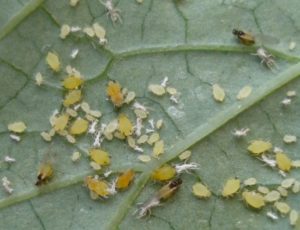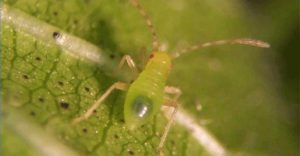by Robert Bowling, Ph.D., Assistant Professor and AgriLife Extension Entomology Specialist
Cotton:
Much of the Coastal Bend and Wintergarden cotton is out of danger for thrips injury. It has been a quiet year for thrips and may give credence that cotton insecticide seed treatments are working fine in Texas. However, frequent heavy rain events around the area have likely helped keep their populations in check.
The cotton aphid is on the prowl. There are reports of cotton aphids building on cotton growing in the Valley. Late last week I found cotton aphids on cotton in several trials at the Texas A&M Agrilife Research and Extension  center at Corpus Christi. Their populations are light to moderate but the aphid seems slow to increase based on observations early this morning. Predators were observed feeding on cotton aphids and they may be responsible for keeping the aphid in check. The aphid should not be confused with the sugarcane aphid. The cotton aphid nymph may vary in color from tan to green and are often marked with a dark head, thorax, and wing pads. The cornicles will be the same color as the body. Wingless adult cotton aphids vary in color from a light green mottled with dark green (most common) but may be whitish, yellow, pale green, and dark green forms. The legs are pale with the tips of the tibia and tarsi black (only the tarsi are black on the sugarcane aphid). The adult cotton aphid will have black cornicles (tailpipes…similar to the sugarcane aphid). The cotton aphid reaches maximum reproduction at temperatures ranging from the lower 70’s to ~ 80 degrees F. An Insecticide application for cotton aphid should be considered when infestations exceed 50 aphids per leaf.
center at Corpus Christi. Their populations are light to moderate but the aphid seems slow to increase based on observations early this morning. Predators were observed feeding on cotton aphids and they may be responsible for keeping the aphid in check. The aphid should not be confused with the sugarcane aphid. The cotton aphid nymph may vary in color from tan to green and are often marked with a dark head, thorax, and wing pads. The cornicles will be the same color as the body. Wingless adult cotton aphids vary in color from a light green mottled with dark green (most common) but may be whitish, yellow, pale green, and dark green forms. The legs are pale with the tips of the tibia and tarsi black (only the tarsi are black on the sugarcane aphid). The adult cotton aphid will have black cornicles (tailpipes…similar to the sugarcane aphid). The cotton aphid reaches maximum reproduction at temperatures ranging from the lower 70’s to ~ 80 degrees F. An Insecticide application for cotton aphid should be considered when infestations exceed 50 aphids per leaf.
It is time to focus attention on cotton fleahoppers. Cotton fleahopper has been reported around the region but I  have yet to hear of economic populations of this annual cotton pest. The recommendation for scouting is to examine the main terminal buds of 25 randomly selected plants at each of four or more locations across the field. During the first 3 weeks of squaring, 15 to 25 cotton fleahoppers per 100 terminals may cause economic damage. As plants increase in size and fruit load, larger populations of fleahoppers may be tolerated without economic yield reduction. If an insecticide treatment for fleahopper is warranted, consider other beneficial arthropods and pests (such as the cotton aphid) that are present prior to selecting an insecticide. Some insect icides are less harmful to beneficial arthropods than others and protecting these biological control agents may prevent a secondary pest outbreak. If other pests, such as the cotton aphid, are present, beneficial arthropods are absent, and a fleahopper
have yet to hear of economic populations of this annual cotton pest. The recommendation for scouting is to examine the main terminal buds of 25 randomly selected plants at each of four or more locations across the field. During the first 3 weeks of squaring, 15 to 25 cotton fleahoppers per 100 terminals may cause economic damage. As plants increase in size and fruit load, larger populations of fleahoppers may be tolerated without economic yield reduction. If an insecticide treatment for fleahopper is warranted, consider other beneficial arthropods and pests (such as the cotton aphid) that are present prior to selecting an insecticide. Some insect icides are less harmful to beneficial arthropods than others and protecting these biological control agents may prevent a secondary pest outbreak. If other pests, such as the cotton aphid, are present, beneficial arthropods are absent, and a fleahopper application is warranted, consider an insecticide that will control both pests. Please access the following link for more information about the cotton fleahopper http://cottonbugs.tamu.edu/fruit-feeding-pests/cotton-fleahopper/.
application is warranted, consider an insecticide that will control both pests. Please access the following link for more information about the cotton fleahopper http://cottonbugs.tamu.edu/fruit-feeding-pests/cotton-fleahopper/.
Last week I had a few questions about applying Transform® (Dow AgroSciences) to cotton for fleahopper management. Currently, the EPA has not approved the Section 3 request for Transform (for use on cotton and other labeled crops). This means that purchases of Transform in 2016 cannot legally be applied to labeled crops (including cotton). Dow AgroSciences is working with the EPA to reinstate the section 3 label and that approval should be coming soon. If you have carry-over product from 2015 it can be used on cotton (and other labeled crops). Transform did receive a Section 18 approval from the EPA for use on Sorghum against the sugarcane aphid. However, this label does not include other crops or crop pests.

Robert Bowling
Assistant Professor and Extension Specialist, College Station, TX robert.bowling@tamu.edu